Ask the Pros: Split shots

Viktor Lyagushkin
Viktor is a National Geographic photographer, official Nikon photographer, Subal Team Pro photographer, winner of many international photo contests and his work has been exhibited in many cities of Europe and America.
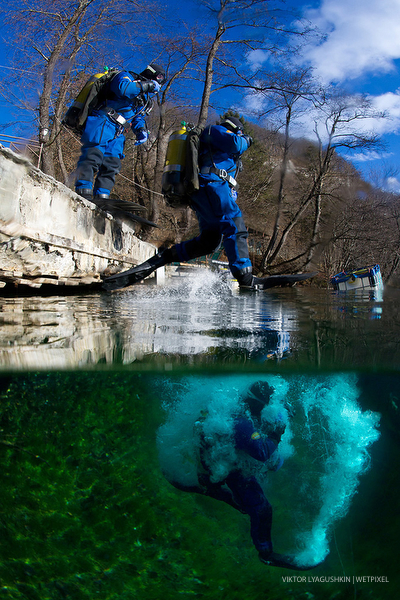
What is your favorite lens for shooting over/under images? Please specify whether you are shooting full frame or cropped sensor. What size dome port do you use?
Nikkor 16 mm fisheye, full frame camera. 8 inches. I think, it is the smallest size to take splits. But if it is bigger it would be better.

How do you expose the images? Do you use tools in post to adjust either underwater or above water exposures?
I use strobes to add light into underwater part but usually still need some correction in Photoshop.
How do you shoot splits of fast moving animals?
I found the only comfort way to do that: short expositions and freezing the moving object with the strobes.
What makes for a great dive site for shooting over/unders? (Shallow reefs, sun angles etc.)
I do not know.
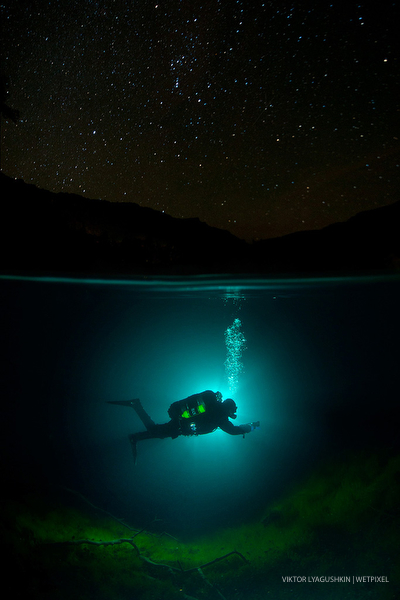
Why do you think over/unders are so popular with people? Do your split level shots sell well? In turn, do you set out to shoot them specifically for this?
Because people see “over” part, which is familiar for them, so they can refer to familiar objects and compare underwater world with their experience. It’s a kind of looking into different world. And looking at this, people can easily imagine they join photographer or a person on the scene and go underwater with him.
As for me, the most interesting are splits where “over” and “under” parts interact with each other; so we have interaction of two worlds, otherwise this would be just two different pics, which you decided to join.
David Salvatori
Diving for passion since 2007, with the greatest aspiration to raise awareness of our endangered nature. His website.
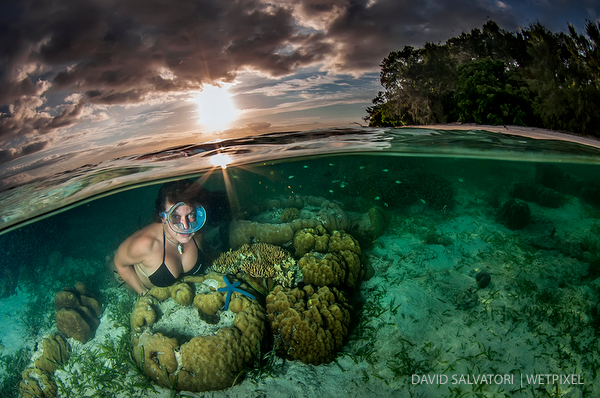
What is your favorite lens for shooting over/under images? Please specify whether you are shooting full frame or cropped sensor. What size dome port do you use?
Sigma fish-eye 15mm sigma, FF. for the dome, definitely a large one is the best choice; I use 9 and 1/2 inches, Seacam superdome
How do you expose the images? Do you use tools in post to adjust either underwater or above water exposures?
When I was in the underwater competitions, I had to present jpegs with no post-processing. I always used to shoot with the sunlight at my back just to have the best luminosity below and to try to find the best balance for the exposure between the under and the over parts of the shot. Sometimes, I also used D-Lighting (a Nikon feature) to work on Lights/Shadows. Of course, in order to have an interesting subject below either you have to have good visibility or a very close subject. Speaking about settings, I usually choose a quite closed aperture (something like f/16) and I focus on the below part (which is “closer” to the focus plan) in order to be sure that also the part above is in focus. So just to recap:
- focus: on the part or the subject in the below part.
- exposure: guided from the past above just to avoid overexposure.
- aperture: quite close to have all in focus
If I shoot raw to post-process later, I tend instead to go with exposure to the right and then, in case, even develop the raw twice in Camera Raw to get two separated layers, each with its correct exposure, to be overlaid later in Photoshop
How do you shoot splits of fast moving animals?
I definitely use hyperfocal: I study the subject’s behavior and I try to observe how close it comes to me; based on that, I choose the aperture and I focus on the hyperfocal distance, then I switch to manual focus; with this measure, I have only to care about composition.
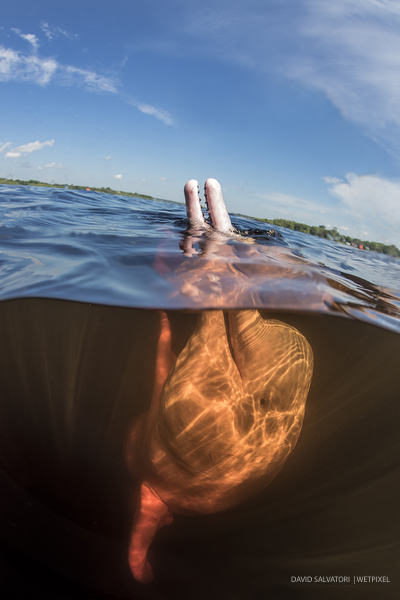
Of course, since we are always looking for closer shots, we might be willing to choose a high values for aperture (f/16 and even above) which will give us closer hyper focal distances and will guarantee us to have all in focus from half of that distance to infinity
What makes for a great dive site for shooting over/unders? (Shallow reefs, sun angles etc.)
Definitely great visibility and/or subjects coming close for the part below; sunsets, sunrises, human activities, great nature landscapes for the part above
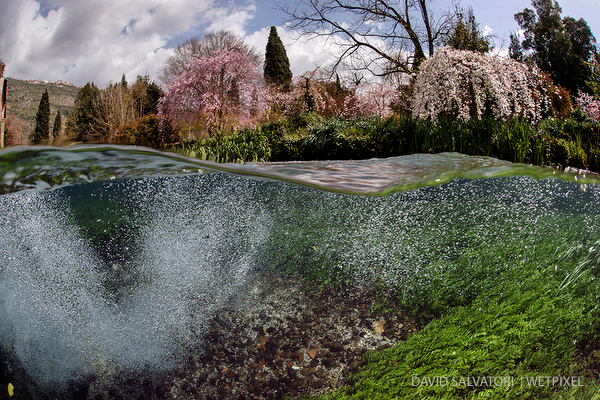
Why do you think over/unders are so popular with people? Do your split level shots sell well? In turn, do you set out to shoot them specifically for this?
They often represent something more “understandable” to non-divers and they usually have a big emotional impact giving a great and different point of view to topside shots. Lately, I was asked to represent differently one of the most famous botanic gardens here in Italy and I chose to use extensively the split shot to represent the fantastic nature of the garden from this unusual point of view
Becky Kagan Schott
Becky Schott is an award winning underwater cinematographer, photographer and technical diving Instructor who specializes in capturing imagery in challenging aquatic environments.
What is your favorite lens for shooting over/under images? Please specify whether you are shooting full frame or cropped sensor. What size dome port do you use?
I like to use a sigma 15mm fisheye for over/under shots. I use a Full frame camera and a 8in dome port on my Aquatica housing.
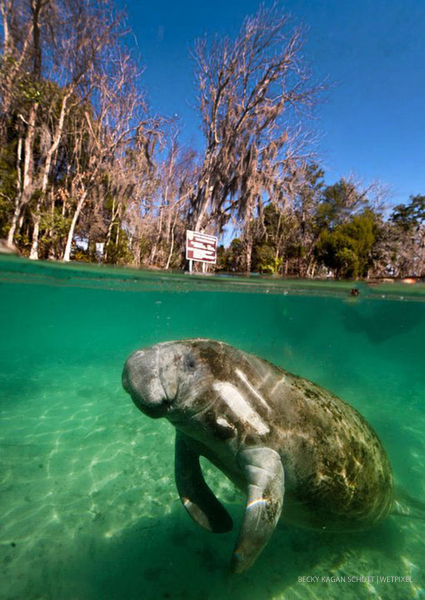
How do you expose the images? Do you use tools in post to adjust either underwater or above water exposures?
I suppose it depends on what my focus is in the shot but I try and expose above water and if possible use a strobe underwater. Later on I correct the images in photoshop and even out the exposure.
How do you shoot splits of fast moving animals?
I use a faster shutter speed,
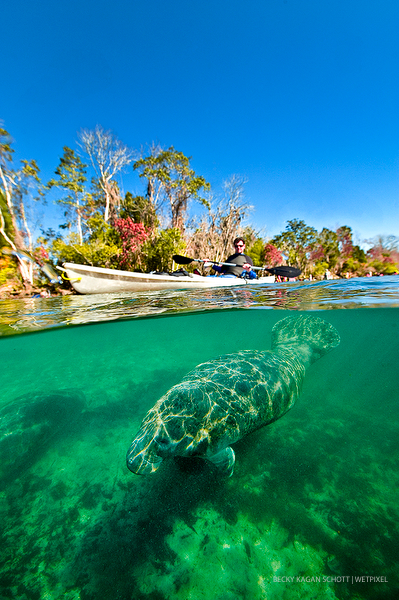
What makes for a great dive site for shooting over/unders? (Shallow reefs, sun angles etc.)
One of my favorite places to shoot over/unders is in Crystal River in the winter time with manatees. They are slow moving and make great subjects for practicing these types of shots. The water is generally pretty clear and calm so it’s a great place to shoot.
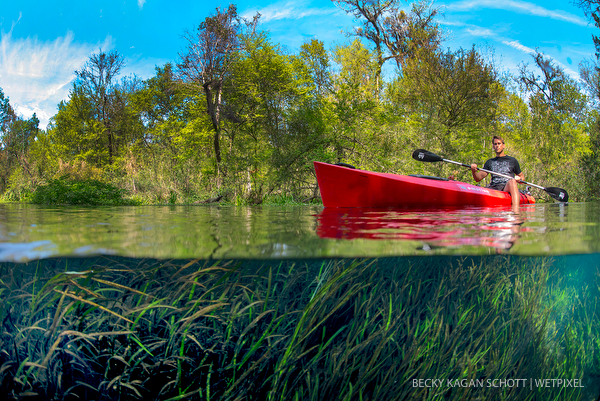
Why do you think over/unders are so popular with people? Do your split level shots sell well? In turn, do you set out to shoot them specifically for this?
I personally love over/unders because it blends our topside world with the underwater world. I love to see the transition between our two worlds, and when a photographer can capture a stunning topside landscape with big animals or vibrant marine life below the surface I think it just draws a viewer in. I do set out to shoot over/unders, I like the challenges of shooting them and trying new techniques.
Page 1: David Doubilet, Franco Banfi, Cristian Dimitrius, Allison Vitsky Sallmon and Andy Sallmon.
Page 2: Matt Smith, Douglas Seifert.
Page 3: Mike Veitch, David Fleetham, Eiko Jones.
Page 4: Viktor Lyagushkin, David Salvatori, Becky Kagan Schott.
Page 5: Rico Besserdich, Julian Cohen, Berkley White.